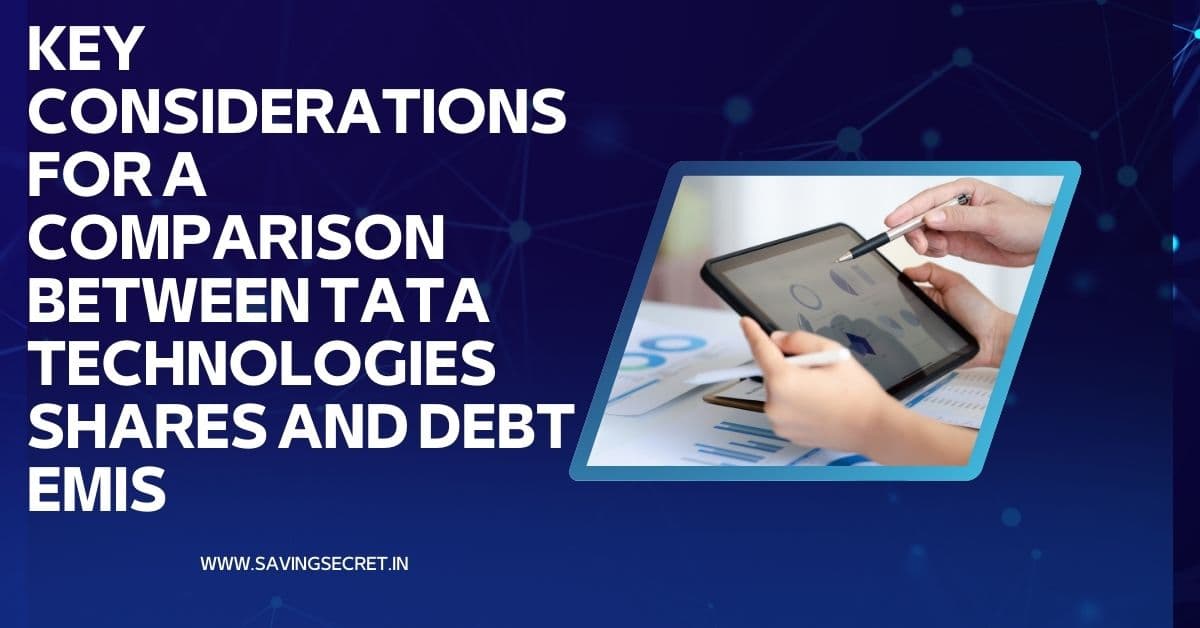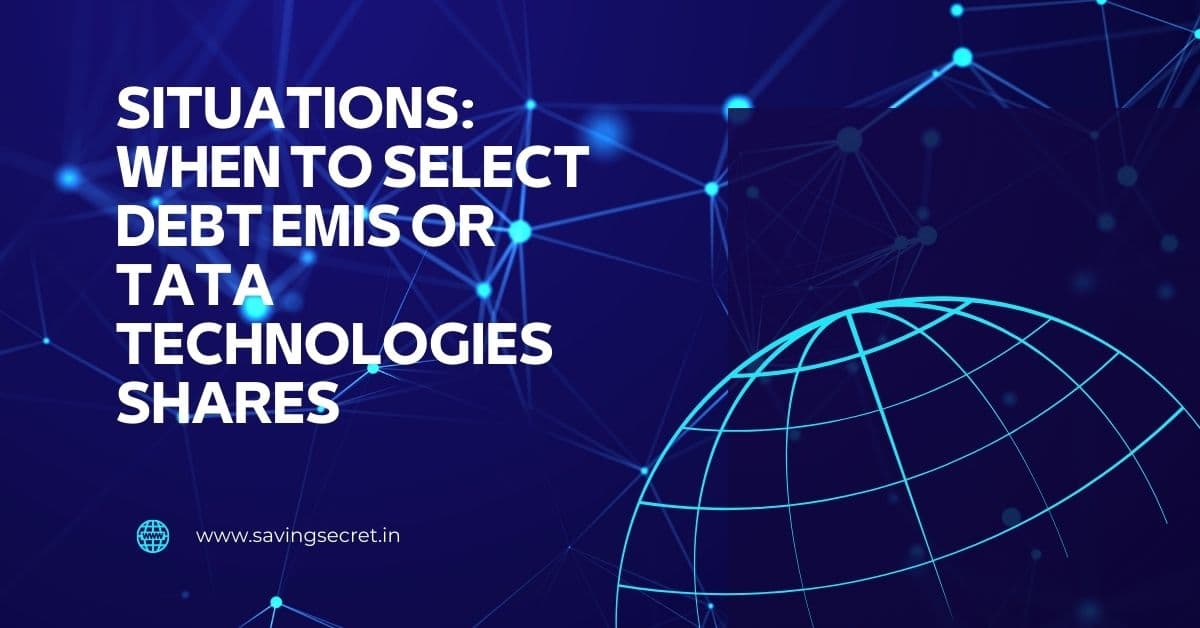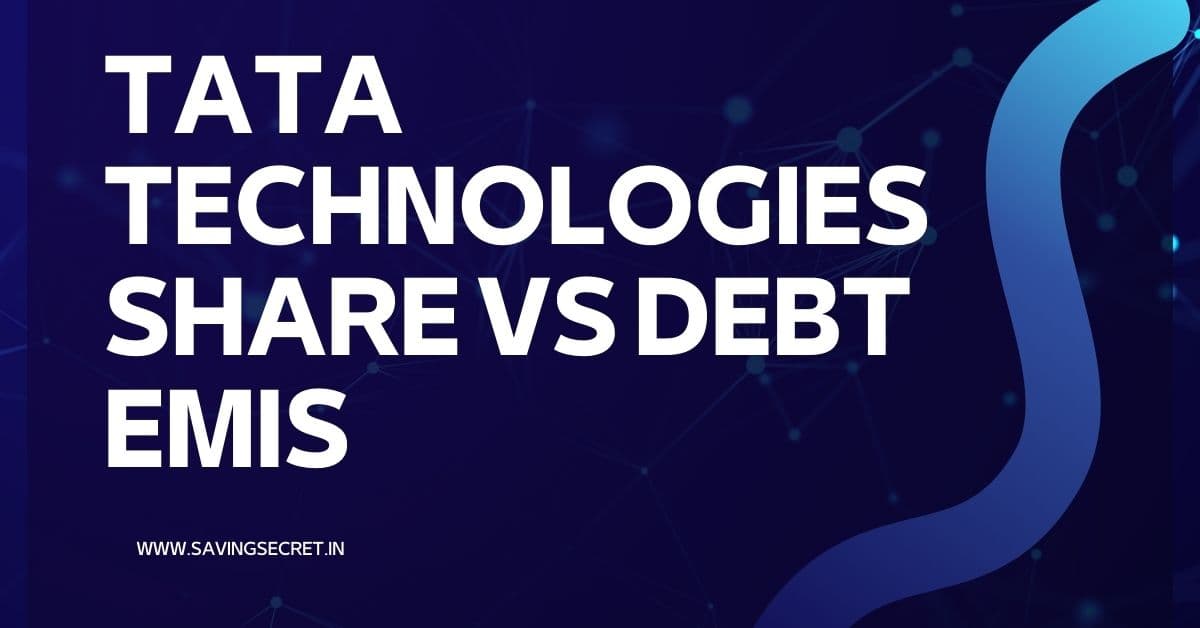Tata Technologies Share vs Debt EMIs: In India, financial planning sometimes entails deciding between controlling debt through EMIs (Equated Monthly Instalments) for large expenditures and investing in stocks to build wealth. The stock performance of Tata Technologies, a multinational engineering and digital services firm, has drawn attention. As of April 2025, its market capitalisation was ₹26,924 Cr. As a result, many Indian investors are debating whether to buy its shares or put their debt repayment EMIs first. In 2025, this choice will be crucial as economic growth (6–7% GDP) and inflation (4–6%) will influence middle-class families, young investors, and salaried professionals’ financial plans.
This tutorial, which is intended for Indian readers, helps you make the best financial decision by contrasting managing debt EMIs with investing in Tata Technologies shares. We offer useful insights, doable actions, and resources to help you match your decision with your financial objectives by utilising Tata Technologies’ financials, market trends, and debt situations unique to India. This post will enable you to strike a balance between managing your debt and accumulating money, regardless of whether you live in Bangalore, Mumbai, or another Tier-2 city.
Comprehending Debt EMIs and Tata Technologies Shares
Shares of Tata Technologies
Established in 1994 as a subsidiary of Tata Motors, Tata Technologies Ltd. provides digital solutions and product development to manufacturing clients worldwide, with a focus on the automotive, aerospace, and industrial industries. FY25’s major financial highlights include:

- Market Cap (mid-cap stock): ₹26,924 Cr.
- Revenue was ₹5,168 Cr, a 1% YoY increase.
- Profit: ₹677 Cr, a decrease of 0.36% year over year.
- Premium to peers at 24.44; P/E ratio: 41.54.
- Debt: Almost no debt.
- Dividend Yield: 0.0% (Q4 FY25 saw no dividends).
- As of April 29, 2025, the share price was ₹663.70, down 25.36% year-to-date.
Market Outlook: Analysts are positive, with target prices of ₹900 to ₹1,400 over 12 to 24 months, led by EV and aerospace growth, despite a 6% decline on April 29, 2025, owing to a possible 3.9% share sale by TPG Rise Climate.
Pro:
- prospects for expansion in the fields of EV and digital transformation.
- strong support from the Tata Group (55.23% promoter ownership).
- A balance sheet devoid of debt improves stability.
Cons:
- Overvaluation is indicated by a high P/E ratio (41.54).
- With Q4 FY25 net profit up 20.12% but sales down 1.18%, revenue growth slowed (by 1% YoY).
- Risks associated with market volatility (Sensex: 80,000–85,000 range).
EMIs on debt
EMIs, which are set monthly payments for credit card purchases or loans (personal, auto, or housing), are typical in Indian homes. In India, typical EMI situations include:
- ₹30,000 to ₹50,000 per month for a home loan (15–20 years, 8–10% interest).
- ₹10,000 to ₹20,000 per month for a car loan (5–7 years, 9–12% interest).
- Personal Loan: ₹5,000–₹15,000 per month for 1–5 years with interest rates ranging from 12–18%.
- Monthly EMI on a credit card: ₹2,000 to ₹10,000 (6–24 months, 12–36% APR).
Pro:
- permits expensive purchases to be made without paying in full up front.
- Budgeting is aided with fixed payments.
- house loan tax advantages (Section 80C, 24(b)).
Cons:
- Interest raises the overall cost (for example, a loan of ₹10 lakh at 10% interest for five years is ₹13.2 lakh).
- A CIBIL score of 700+ is required for favourable lending terms, and missed EMIs lower that score.
- Monthly budgets are strained by high EMIs, particularly in metropolitan areas where rent ranges from ₹15,000 to ₹30,000.
Context: With over 10 crore demat accounts and expanding loan penetration (home loans will reach ₹25 lakh crore in 2025), Indians must decide whether to pay off debt by clearing EMIs or invest in equities like Tata Technologies for development.
Key Considerations for a Comparison between Tata Technologies Shares and Debt EMIs
Consider these variables specific to Indian financial reality while choosing between paying off debt EMIs and investing in Tata Technologies shares.

1. Time horizon and financial objectives
- Short-Term (1–3 years): To prevent rising expenses, provide high-interest debt (such as a credit card: 36%) priority EMIs. For instance: Interest savings of ₹36,000 per year may be achieved by paying off a ₹1 lakh credit card EMI at 36%.
- Medium-Term (3–5 years): Make minor investments in Tata Technologies through SIPs (₹2,000–₹5,000/month) while balancing low-interest EMI payments (e.g., house loan: 8%).
- Long-Term (5+ years): If debt is manageable (EMI < 30% of income), invest in Tata Technologies to build wealth. A Sensex ETF investment of ₹5,000 per month may increase to ₹12.3 lakh in ten years at a 12% CAGR.
Context: Common medium-term objectives include schooling (₹5–15 lakh) and marriage (₹10–20 lakh). India’s goal of 30% EV adoption by 2030 is in line with Tata Technologies’ EV strategy.
2. Tolerance for Risk
- Shares of Tata Technologies are at high risk because of overvaluation (P/E: 41.54) and market volatility (25.36% YTD decrease). ideal for investors with a two to three year horizon that are risk averse.
- Debt EMIs: Low risk, but they reduce investing capital by securing cash into fixed payments. Credit ratings are affected by high-interest EMIs, such as personal loans, which are riskier to default on.
Context: While youthful professionals in IT areas like Bangalore welcome equities risks, conservative investors—such as retirees—prefer debt repayment.
3. Costs versus Returns
- Shares of Tata Technologies: Although the Sensex’s historical returns (~12% CAGR) point to possible increases, the company’s latest results (20.12% profit growth, 1.18% sales reduction) temper expectations. By 2027, analysts anticipate returns of 10–15%.
- Debt EMIs: It costs ₹7.1 lakh (plus ₹2.1 lakh in interest) to pay off a ₹5 lakh personal loan at 15% over five years. While early repayment reduces interest costs, investment profits are forfeited.
A Comparative Example:
- Making a monthly investment of ₹10,000 in Tata Technologies: ₹10,000 every month for five years, at a 12% CAGR, equals ₹8.1 lakh.
- Making a monthly EMI payment of ₹10,000 on a loan of ₹5 lakh (15%): ₹6 lakh (plus ₹1 lakh interest) is the total cost. At 12%, the remaining ₹5,000 per month is invested, making it ₹4.05 lakh.
- Result: While EMI clearing frees up future cash flow and raises credit score, investing yields ₹2.1 lakh more.
Context: Investment is feasible with low-cost EMIs since home loans (8–10%) are less expensive than personal loans (12–18%).
4. Budget and Cash Flow
- Shares of Tata Technologies: Needs money left over after EMIs and necessities. With a ₹15,000 EMI and a ₹50,000 pay cheque, ₹10,000–₹15,000 is left over for investments.
- High debt EMIs, such as ₹20,000 on a salary of ₹40,000, put a pressure on budgets and increase the chance of default. If EMI payments account for more than 30% of revenue, give them priority.
Context: Investment potential is constrained by metro living expenses (rent: ₹15,000–₹30,000). To balance both, apply the 50/30/20 rule: 50% necessities, 30% desires, and 20% debt or savings.
5. Implications for Taxation
- Shares of Tata Technologies: 10% tax on long-term capital gains (LTCG) over ₹1 lakh; 15% tax on short-term gains. Any dividend income is subject to slab rates of taxation.
- Debt EMIs: Sections 80C and 24(b) provide for tax deductions for home loan principle (up to ₹1.5 lakh) and interest (up to ₹2 lakh). No tax advantages for auto or personal loans.
Context: EMIs are appealing since salaried professionals in the 30% tax percentile save between ₹45,000 and ₹60,000 a year on house loan deductions.
Situations: When to Select Debt EMIs or Tata Technologies Shares

Select Tata Technologies Share if:
- Low-Cost Debt: loans have low interest rates (e.g., home loan: 8%), and EMIs are less than 20% of income.
- High Risk Tolerance: Able to tolerate a two- to three-year timeframe and market volatility.
- After EMIs and necessities, a monthly surplus of ₹10,000 to ₹20,000 is available.
- Long-term objectives include saving for children’s education (₹15 lakh in ten years) or retirement (₹1 crore in twenty years).
- For instance, an individual earning ₹75,000 per month with a ₹15,000 house loan EMI can invest ₹10,000 per month through SIPs in Tata Technologies, with the expectation of earning ₹8–10 lakh in 5–7 years.
Decide on debt EMIs if:
- High-Interest Debt: If unpaid, credit card or personal loans with interest rates greater than 12% increase expenses.
- Low Cash Flow: EMIs exceed 30% of income, putting defaults at danger.
- Low Risk Tolerance: Give preference to monetary stability above unpredictability in the market.
- Short-term needs include debt relief in order to be eligible for new loans, such as a house loan with a CIBIL of greater than 750.
- Example: To save ₹50,000 to ₹1 lakh in interest over three years, a ₹40,000/month income with a ₹15,000 personal loan EMI should prioritise payments.
Context: Middle-class households frequently balance home debts with holiday spending (between ₹10,000 and ₹50,000 for Diwali). Flexibility for cultural obligations is ensured by paying off high-interest debt.
The Ultimate Strategy: Balancing Both
- A hybrid strategy maximises wealth while controlling debt for the majority of Indian investors:
- Prioritise High-Interest EMIs: To reduce interest, pay off personal loans (15%) or credit cards (36%).
- Keep Low-Cost EMIs: For affordability and tax advantages, keep house loans around 8%.
- Invest Little: To accumulate money, begin SIPs in Tata Technologies or Sensex ETFs at a rate of ₹2,000 to ₹5,000 every month.
- Create an Emergency Fund: Put aside ₹1-2 lakh in a liquid fund to pay for six months’ worth of bills and EMIs.
- Monitor and Modify: Keep tabs on Tata Technologies’ performance and EMI schedules using tools like Groww or Moneycontrol.
An example plan with a salary of ₹50,000:
- EMIs: ₹10,000 (8% for a property loan).
- Investment: Tata Technologies ETF, ₹5,000 per month.
- Monthly savings: ₹5,000 in liquid funds.
- 25,000 for necessities (rent, food, and transportation).
- Discretionary: ₹5,000 for entertainment and meals.
As a result, debt is decreased, wealth increases (by about ₹4 lakh in 5 years), and stability is guaranteed by an emergency fund.
Context: Popular in cities, apps like ZeeMoney and ET Money link investments and EMIs.
Resources and Tools for Indian Investing
- Moneycontrol, Groww, ET Money, and Tickertape are stock tracking platforms.
- EMI Calculators: HDFC Bank, BankBazaar, and Paisabazaar.
- Apps for budgeting include Moneyview, ZeeMoney, and Moneycontrol.
- Investment platforms include Paytm Money, Groww, Kuvera, and Zerodha.
- Learning Resources: YouTube (CA Rachana Ranade, Pranjal Kamra), SEBI’s investor portal, and NSE India.
- Community: For peer guidance, join Reddit’s r/IndiaInvestments group.
Context: In places like Uttar Pradesh and Bihar, Moneycontrol’s Hindi News Section provides assistance to non-native English speakers.
Problems and Solutions
Problem 1: Volatility of the Market
The 25.36% year-to-date decline in Tata Technologies worries cautious investors. Solution: To average expenses, invest through SIPs and hold for two to three years.
Problem 2: Elevated EMI Cost
Budgets are strained when EMIs exceed 30% of income. Solution: Lower EMIs by extending tenures or refinancing high-interest loans (such as those with 15% to 10% interest).
Problem 3: Insufficient Knowledge of Finance
A large number of Indians are ignorant about borrowing fees and stock values. Solution: For free education, use Zerodha Varsity or Moneycontrol’s Learn Section.
Problem 4: Expenditures on Culture
Weddings and festivals take money away from EMIs or investments. Solution: Use Moneycontrol’s Budget Planner to set aside between ₹10,000 and ₹50,000 per year for cultural costs.
Context: Lack of awareness affects rural investors. YouTube influencers and bank applications help to close this gap.
Conclusion
Your financial objectives, risk tolerance, and cash flow will all play a role in your decision between Tata Technologies shares and debt EMIs. For long-term wealth, investing in Tata Technologies offers development potential (10–15% returns by 2027), and paying off high-interest EMIs improves creditworthiness and saves money. The majority of Indian investors in 2025 want a balanced strategy that prioritises high-cost loans, maintains low-cost EMIs, and makes minor investments. Make sure your financial decisions are in line with India’s dynamic economy by using tools like Moneycontrol and Groww to watch markets and EMIs.
Urgement: Take charge of your money right now! Start a ₹2,000 SIP on Groww, compute EMI savings on BankBazaar, and examine Tata Technologies’ performance on Moneycontrol. For professional guidance, join r/IndiaInvestments or leave a comment with your approach!
Medical Emergency Expenses Expenses? Here’s Your Financial Survival Guide
Effective Chit Fund Debt Solutions for Middle-Class Indians
Gold Loan vs Personal Loan: Which is Better for Debt Relief?
